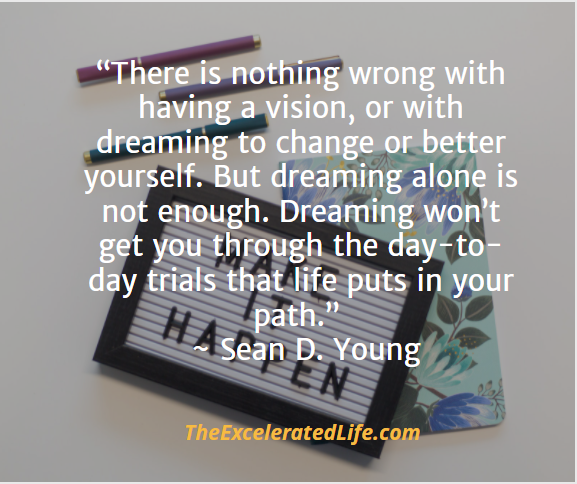Here is a proven formula for making a lasting change. Start with a dream. Break it down into long- and short-term goals. Break your goals into steps. Take the next step.
TheExceleratedLife.com
Title Photo by The Lazy Artist Gallery from Pexels

[What you may learn: After reading, see if you can name a difference between dreams, goals, and steps.]
Setting a BIG Goal
Sara had a BIG – Bold, Important, Gratifying – goal. She was going to lose 15 pounds. Her 10-year class reunion was coming up and she wanted to look good. So Sara came up with a plan.
- Get some new walking shoes.
- Schedule times during the week to go for a walk.
- Invite a friend to go walking with her.
- Remove the junk food from her house.
- Pick up some healthy snacks at the grocery.
- Buy some fruits and vegetables.
- Learn to cook 3 new healthful meals.
Sandy had a BIG goal, too. Sandy was going to lose 50 pounds. The 25th class reunion was coming up and Sandy wanted to look better. This was the plan.
- Get some new walking shoes.
- Explore ways to be more active.
- Join a gym.
- Set up a meeting with a nutritionist.
- Remove the junk food from the house.
- Buy some fruits and vegetables.
- Learn to cook 7 new healthful meals.
Sam also had a BIG goal. He was going to lose 100 pounds. Sam’s 50th class reunion was coming up and Sam wanted to look OK. And Sam had a plan.
- Get some new walking shoes.
- Schedule times during the week to go for a walk.
- Get a personal trainer.
- Look into fasting diets.
- Try to eat healthier.
- Buy some fruits and vegetables.
- Learn to cook 10 new healthful meals.
Goals and Steps
Notice anything about the goals of our three friends? Their outcomes vary widely – losing 15 vs. 50 vs. 100 pounds – but they all came up with seven steps to reach their goal. “Most people,” writes Dr. Sean Young in Stick With It, “when asked to write a list of steps to accomplish something, would come up with three to ten steps” regardless of the size of the goal. [Young]
The size of the steps you come up with depends on the size of the goal. The bigger the target, the bigger your steps are likely to be. And as we see, some of the steps are more achievable than others.
The Stepladders Model: Dreams, Goals, Steps
To help people make a change and stick with it, Dr. Young uses a “stepladder model” that looks similar to this:
______
_______|Dreams
______|Goals
|Steps
Or you could look at it this way: Dreams -> Goals -> Steps.
You start with a dream and break it down into long- and short-term goals. Then you break your goals down into steps. Let’s take a look at each of these components.
A Dream is . . .
The dream is your starting point. Dreams are bigger than goals. They “typically take more than three months to achieve”. [Young] And importantly, a dream is something which you have never achieved before. If it’s something you’ve done in the past and want to do again, it’s a goal. [Young]
A Goal is . . .
“Goals are the intermediate plans people make.” [Young] Goals represent the targets you’ll hit on your way to realizing your dream.
Dr. Young distinguishes between long-term and short-term goals. In his model, a long-term goal typically takes three months or longer to reach, IF you’ve done it before. If you’ve never done it, it’s a dream. (See above.) Short-term goals usually take from a week to a month.
This is Young’s timeline. You may use a different one. For example, I would put a long-term goal at six months to a year and a short-term goal of one to three months. But the main idea is to break long-term goals into short-term ones, with correspondingly smaller steps.
A Strategy is . . .
Having dreams, long-term goals, and short-term goals enables you to develop a strategy. Your strategy is your plan for achieving your short-term goals, which leads to the achievement of your long-term goals, and, ultimately, your dream.
In his book, How Will You Measure Your Life?, Clayton M. Christensen identifies two different strategies.
A deliberate strategy means following a plan focused on anticipated opportunities.
An emergent strategy arises from your day-to-day decisions which may lead you to pursue unanticipated opportunities or to solve unanticipated problems.
When you have a clear idea of where you want to go (i.e., a dream), the deliberate strategy is your method of getting there.
Having a goal is a must if you want to make progress in a clear direction, but as we’ve discussed before, developing a system is the means to get you there. “The goal determines the process,” Grant Cardone writes in The 10X Rule, but the process is absolutely necessary.
Most goals can’t be accomplished without systems. But it’s pointless to develop a system that has no goal. The goal and the system need each other, so set your goal, then develop your system for reaching it. That is, break it down into steps.
A Step is . . .
Central to Dr. Young’s strategy is the concept of stepladders. Stepladders, as you may suppose, are made up of steps – the steps are the little tasks you check off on the way toward your goal. [Young] A step typically takes less than a week to accomplish. Some people advocate for making a step something you can accomplish in a day, or even in a few minutes.
However you break down your short-term goals into steps, remember that if a step is too big, you won’t do it. A step may seem reasonable in the excitement of planning a new strategy, but once reality sets in, the step must be something you can and will stick to, day in and day out. Steady wins the race.
The Purpose of Stepladders
“Stepladders . . . bring together dreams, goals, and steps [and] teaches that dreams are important for motivation, but focusing entirely on dreams can lead people to plan steps that are so big that they quit doing things early . . . You need to focus on completing small, concrete goals to calibrate the mind and apply stepladders correctly.” [Young]
The purpose of stepladders? To keep you on the path.
“It’s important to understand that stepladders isn’t a formula for accomplishing dreams. It’s a formula for keeping you on a path.” [Young]
Why Stepladders Work
There are proven scientific reasons why stepladders work. For one, stepladders allow you to take your outcome goals (long- and short-term) and turn them into process goals.
Remember, you have little or no control over outcomes. But you can break the desired outcome into the steps you must take to reach your destination.
Process goals are measurable, so you know what you must do and you know when you’ve done it. This leads to a greater sense of internal control and improved self-confidence. Keep your goal in mind, then focus on effort, not results.
Here’s another reason stepladders work. Each time you complete a step, your brain releases dopamine, and that feels good. If you focus on your outcome goal, you are only successful when (or if) you complete the goal – delayed reward. But when you focus on the process, your stepladder steps, you get a shot of dopamine every time you complete the step; an immediate reward that you can receive multiple times.
Where Do I Go From Here?
[Before you read further, take a moment to test yourself on what you’ve read, per the question at the beginning of this article. Name a difference between dreams, goals, and steps. Got it? Good. Now continue to see if you got it right.]
Are you ready to put these ideas to use? Here’s a plan.
Write down your BIG goal. Is it a goal (something you’ve done before, which can take from one to three months or more)? Or a dream (will take three months or longer + you’ve never done it before)?
If it’s a dream, make a list of long-term goals. Break them down into short-term goals.
Now, list the steps (small, incremental actions that take no more than a week) to achieve the first goal.
Success Is A Skill
Think about an important goal you have reached in the past. How did you achieve it? If you did it once, you can do it again. A large part of success is skill. And like any other skill, you can improve it with practice.
Dreams are an important part of self-development and improvement in order to give our best Service to the world. But a dream by itself won’t get you very far. “Dreaming,” Dr. Yourng reminds us, “won’t get you through the day-to-day trials that life puts in your path.”
“The lesson is to focus on finding the right first step. Put all of your energy into achieving that first little step. Take the time to reflect on your progress. And then repeat.” [Young]
Success is a skill. Set your goal. Identify the steps. Put all your energy into taking that first step. Celebrate your progress. Repeat. That’s how you embrace your Excelerated Life™!
Excelerated Goal Setting™ — planning and achieving BIG (Bold, Important, Gratifying) goals — is one step in creating your Excelerated Life™, a life of flourishing and well-being, and a life of meaning, purpose, and service.
Read more about the Excelerated Life™.
Resources:
Cardone, Grant. The 10X Rule: The Only Difference Between Success And Failure. Hoboken, NJ: John Wiley & Sons, Inc., 2011.
Christensen, Clayton M. How Will You Measure Your Life? New York: HarperCollins Publishers Inc., 2012.
Young, Sean D. Stick With It. New York: HarperCollins Publishers Inc., 2017.



One Reply to “Steps <- Goals <- Dreams”